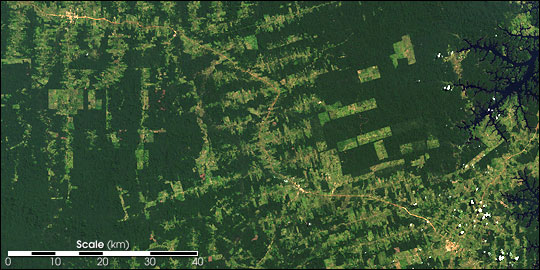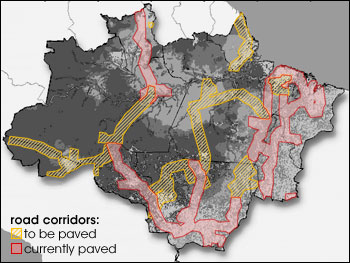

Amazonia’s Future | |||
Nepstad hopes his research will help Brazil prepare. Along with colleagues from Brazil, Nepstad formed a research and education institute in Brazil called IPAM (which in Portuguese stands for Instituto de Pesquisa Ambiental da Amazonia, or, in English, the Amazon Institute of Environmental Research). IPAM provides scientific expertise to governments and conservation groups throughout the country who are trying to develop good land management policies for the Amazon but lack the information they need to create them. It’s hard not to think that the Amazon is doomed, but Nepstad still has hope. “I really do feel optimistic,” he says, “but I admit I have lowered my expectations. When I first started research in the Amazon, my colleagues and I used to talk about preserving the whole thing as some sort of ‘last great sanctuary.’ But to do that we would be asking the Brazilian government and people to do something that no other civilization has managed to do. Instead, we think we have to focus on an Amazon with people in it, but people who are making their living in a sustainable way from the forest.” |
|||
 | |||
Nepstad and his colleagues at IPAM don’t, for example, try to fight every single road that is planned for the Amazon frontier, even though their analysis of satellite imagery collected over the already developed frontier suggests that Brazil’s current road paving plans will likely stimulate an additional 120,000-270,000 square kilometers of deforestation and forest impoverishment. Instead, he hopes the research will help the government see the wisdom in investing more in roads that will link existing frontier communities. |
Development in the Amazon usually extends from roads cut through the forest. This true-color Landsat Enhanced Thematic Mapper plus (ETM+) image of a portion of the Brazilian state of Pará was acquired on July 9, 2001. (Image by Robert Simmon, based on Landsat data provided by the UMD Global Land Cover Facility.) | ||

Nepstad thinks the best chance for the sustainable use of the forest will come from policies geared toward encouraging landowners to make more intensive use of the already developed land along the frontier rather than allowing the frontier to expand farther into the forest interior. Nepstad sees an Amazon that is a network of parks and preserves interspersed with permanent, well-managed agricultural areas, and the harvest of sustainable timber and other forest products. |
Paved roads accelerate forest degradation, enabling damage up to 50 km from the path of the road. This map shows areas currently influenced by paved roads (red) and areas vulnerable to planned road paving (yellow). The planned paving projects will isolate areas of virgin forest from one another, and allow development in previously inaccessible regions of the Amazon. (Map adapted from Nepstad et al., 2001) | ||
He’s optimistic, but nevertheless seems saddened by some of the destruction he’s seen in the 20 or so years he has been visiting the Amazon. He described seeing an intense canopy fire consume all of the few remaining trees left in an already burned patch of forest. “Once I was about 50 meters from a crown fire moving through a patch of logged forest, and I couldn’t get any closer—it was so hot. That for me symbolizes what we are trying to prevent—a patch of forest with only a few trees remaining, and then even that goes up in flames and there is nothing left.”
|
| ||